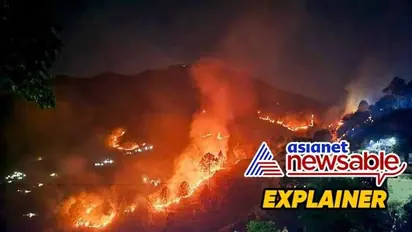Explained: What triggers forest fires in Uttarakhand

Synopsis
Forest fires have become a severe and recurring problem in Uttarakhand, particularly during the dry and hot months between February and June. This April, the state has experienced a significant surge in forest fires, with 6,701 instances reported compared to 900 during the same period last year
Forest fires in Uttarakhand have become a recurring and severe problem, particularly between February and June, when dry and hot weather conditions prevail during the daytime. Uttarakhand has witnessed a dramatic increase in forest fires this April, with 6,701 instances reported compared to just 900 during the same period last year, according to data from the Forest Survey of India.
Over the past 72 hours alone, the hill state has faced 108 forest fires, causing damage to more than 142 hectares of forest land, predominantly in the Kumaon region.
Responding to the crisis, the Indian Air Force deployed two helicopters, while the Army assisted forest officials in extinguishing fires raging in the popular tourist destination of Nainital. The primary reasons behind these destructive blazes are attributed to the lack of moisture in the forest landscape. The accumulation of dry leaves, pine needles, and other highly flammable materials on the forest floor serves as ready fuel for fires.
Experts have linked this year's alarming surge in forest fires to an exceptionally dry winter, followed by below-normal spring rainfall. The lack of winter precipitation, including snow, has been a significant contributing factor. The Himalayan region experienced a dry spell from September onwards, which was not offset by subsequent rainfall. By January, the region faced an overall rain deficiency of 58%, particularly affecting northwest India where rain levels were 91% below normal. Although February saw some improvement with increased rainfall due to western disturbances, it was insufficient to adequately replenish the region's water resources. These dry conditions have heightened the risk of forest fires, underscoring the urgent need for enhanced measures to prevent and combat wildfires in Uttarakhand.
Besides, human activities account for over 90% of these fires, with locals sometimes deliberately setting fires to clear land for agriculture or encourage fresh grass growth for grazing. However, these fires often spiral out of control.
Campers and tourists are also culprits, unintentionally starting fires through careless actions like discarding lit cigarettes or poorly managed bonfires.
Natural factors such as lightning strikes also contribute to fire outbreaks, particularly in remote areas. Changing climate patterns, characterized by hotter and drier weather, have exacerbated the frequency and intensity of forest fires.
Uttarakhand's topography, dominated by 70% forest cover, accelerates fire spread and complicates firefighting efforts. While the forest department has initiated measures like controlled burning and the creation of fire lines to contain fires, experts stress the need for more proactive measures to prevent fires from escalating.
They advocate for improved firefighting equipment and training, alongside satellite monitoring and early warning systems. Environmentalists emphasize the critical role of local communities as first responders in detecting and extinguishing forest fires.
Suresh Bhai, founder of the environmental NGO Himalaya Bachao Abhiyan, underscores the importance of empowering local communities through employment opportunities under the Mahatma Gandhi National Rural Employment Guarantee Act (MNREGA) to protect nearby forests effectively.
Recent efforts to combat the forest fires include the deployment of an Indian Air Force (IAF) helicopter to assist in extinguishing fires in Nainital, where the situation has worsened. The forest fires have affected a significant area, prompting arrests for arson and necessitating the involvement of army personnel and forest officials. The escalating fire incidents have reached residential areas, prompting precautionary measures and calls for enhanced efforts, including seeking army assistance for containment.
Stay updated with the Breaking News Today and Latest News from across India and around the world. Get real-time updates, in-depth analysis, and comprehensive coverage of India News, World News, Indian Defence News, Kerala News, and Karnataka News. From politics to current affairs, follow every major story as it unfolds. Get real-time updates from IMD on major cities weather forecasts, including Rain alerts, Cyclone warnings, and temperature trends. Download the Asianet News Official App from the Android Play Store and iPhone App Store for accurate and timely news updates anytime, anywhere.